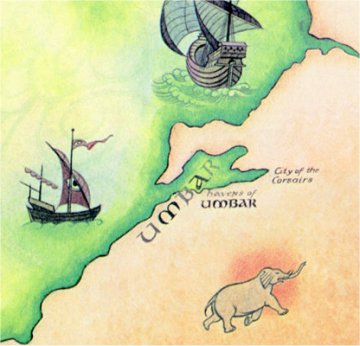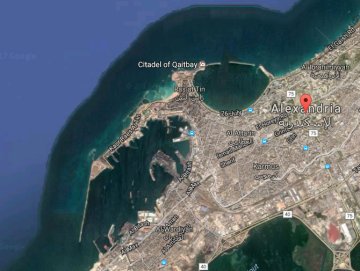Q: What Is the Meaning of Umbar (the City Name)?
ANSWER: It may seem a bit cheeky to some but we have always wondered where Tolkien could have gotten the name Umbar and, what, if anything, it might refer to the in the real world. Tolkien often used real words fitted to his stories so as to disguise their origins. These were clever linguistic puns and every now and then I stumble across a paper that explains one. To date I don’t think I have seen anyone attempt to explain where Tolkien might have gotten the word.
There is an elvish word umbar that is translated as “fate”. However, Tolkien wrote that the name of the great haven established or conquered by Numenor and later by Gondor was of forgotten origin, thus implying that it was not a direct borrowing from elvish. I won’t rule out the possibility that he might have intended it to be an indirect borrowing from elvish, but that would mean there was a prophetic component to the haven’s name.
And there appears to be some confusion among readers about what the name Umbar refers to. Is it the city or the land where the city can be found? Is it both?

Based on Christopher Tolkien’s commentary in The Peoples of Middle-earth it seems to me that the name referred to the region before there was a city, at least in his father’s earlier conception: “(It is probable that when my father wrote this he did not yet suppose that Umbar was a Numenorean fortress and harbour at the time of Ar-Pharazon’s landing.)” In another early draft for “The Tale of Years” J.R.R. Tolkien wrote: “2000-3000. The Numenoreans now make permanent dwellings on the shores of Middle-earth, seeking wealth and dominion; they build many havens and fortresses. The Elf-friends go chiefly to the North-west, but their strongest place is at Pelargir above the Mouths of Anduin. The King’s Folk establish lordships in Umbar (12) and Harad and in many other places on the coasts of the Great Lands.”
The note referenced in that entry reads: “12. This is the first reference to the establishment of a Numenorean settlement at Umbar before the landing of Ar-Pharazon (see p. 156, $41).”
I don’t think we need an exhaustive list of examples. I think some readers mistake the name Umbar for the name of a city (the City of the Corsairs). And yet even in the published text Tolkien uses it to refer to a region, not merely a city:
‘Aye, curse the Southrons! ‘ said Damrod. ` ‘Tis said that there were dealings of old between Gondor and the kingdoms of the Harad in the Far South; though there was never friendship. In those days our bounds were away south beyond the mouths of Anduin, and Umbar, the nearest of their realms, acknowledged our sway. But that is long since. ‘Tis many lives of Men since any passed to or fro between us. Now of late we have learned that the Enemy has been among them, and they are gone over to Him, or back to Him-they were ever ready to His will-as have so many also in the East. I doubt not that the days of Gondor are numbered, and the walls of Minas Tirith are doomed, so great is His strength and malice.’
Here Damrod says Umbar is “the nearest of [the Haradrim’s] realms” to Gondor. And yet, based on what you can easily find in Appendix A, it’s easy to see why readers believe Umbar is just a city:
Eärnil I, his nephew, who succeeded him, repaired the ancient haven of Pelargir, and built a great navy. He laid siege by sea and land to Umbar, and took it, and it became a great harbour and fortress of the power of Gondor. But Eärnil did not long survive his triumph. He was lost with many ships and men in a great storm off Umbar. Ciryandil his son continued the building of ships; but the Men of the Harad, led by the lords that had been driven from Umbar, came up with great power against that stronghold, and Ciryandil fell in battle in Haradwaith.
For many years Umbar was invested, but could not be taken because of the sea-power of Gondor. Ciryaher son of Ciryandil bided his time, and at last when he had gathered strength he came down from the north by sea and by land, and crossing the River Harnen his armies utterly defeated the Men of the Harad, and their kings were compelled to acknowledge the overlordship of Gondor (1050). Ciryaher then took the name of Hyarmendacil ‘South-victor’.
Here it seems obvious that Tolkien is using the name Umbar to refer to a city or very small area. But it is not uncommon for cities to give their names to the lands around them, or to take their names from the lands around them. I think Tolkien meant to blend these two uses or meanings for the name. After all, he speaks elsewhere of “three fleets” coming from Umbar, something that seems unlikely for a single city. Each fleet would have its own commander, so you could argue that perhaps the city was ruled by a council of (at least three) lords who had their own fleets. Or there could have been smaller havens near the City of Corsairs that were considered to be part of Umbar.
What we can be sure of is that Tolkien included Umbar in his descriptions of the coast lands of Middle-earth. Gondor ruled the coasts as far south as Umbar, and the Numenoreans conquered the coast lands and established havens among them. Tolkien clearly applied the name to both the peninsula and the city (haven) in the paragraph following the two I quoted above:
The might of Hyarmendacil no enemy dared to contest during the remainder of his long reign. He was king for one hundred and thirty-four years, the longest reign but one of all the Line of Anárion. In his day Gondor reached the summit of its power. The realm then extended north to Celebrant and the southern eaves of Mirkwood; west to the Greyflood; east to the inland Sea of Rhûn; south to the River Harnen, and thence along the coast to the peninsula and haven of Umbar …So the name was given to the coastal region and subsequently to the Numenorean haven …
In The Peoples of Middle-earth Christopher Tolkien speaks of the “corsair-kingdom” in passing, so it was a “kingdom”, a “realm”, a coastal area, and a city.
Where Did Tolkien Get the Name “Umbar”?
I turn now to where Tolkien could have gotten the name. I can’t prove anything, mind you, but I think it’s an interesting name. The word “umbar” actually occurs in (and can be formed in) many historical languages, including Malay and Indonesian, Punjabi, Arabic, and possibly also Hebrew and Egyptian. It occurs as a given name, and a family name, and a nickname. According to some (dubious, in my opinion) sources the name is traced to a French origin.
I prefer the Arabic hypothesis: um(ma) + bar(r). This compound would be literally translated by most English speakers (using a reference) as “mother (of) coast” but according to a letter published in the New York Times in 1991, written by retired United Nations translator Louis Jay Herman, um(ma) is really used to mean “chief”, “main”, or “principal” when paired with other words in Arabic. Hence, I think one reasonable interpretation would be “the Great Coast” or “the Main Coast”, not necessarily of Middle-earth but of a specific region where a natural harbor was to be found.
The general assumption that many of Tolkien’s obscure names may be connected to ancient elvish roots does not conflict with this hypothesis. For example, some writers suggest that Umbar could be connected to -mbar. It would be a clever play on Tolkien’s part to devise a word from a real language that could also have a meaning in one of his imaginary languages. It could also be an unintentional borrowing, as he suggests that his use of Erech was unintentional. And Gondor is another name that a curious reader asked about, wondering if it was related to Ethiopian Gondar. One can look too deeply for hidden references that are not really there in Tolkien’s work. But how do you know for sure?
An Arabic origin for Umbar appeals to me because it resembles the names of famous cities like Zanzibar. Zanzibar is a Persian (Farsi) name and there are other cities along the Indian Ocean whose names end in -bar (such as Zinjibar in Yemen). I don’t know how the Arabic and Persian words are related (they both have the same meaning). And there is also a Sanskrit word, udumbara, that refers to a legendary tree but I don’t think that is connected to the legend of Ar-Pharazon landing at Umbar. However, there is a book from 1922 called The Hawk of Egypt (written by American author Joan Conquest) which mentions a “Sheikh el-Umbar”. I doubt Tolkien was familiar with this book or another book by Conquest, Desert Passions, that mentions the same sheikh (and his family).
However, if you look hard enough you’ll find at least one place named Umm Barr (either in Oman or the United Arab Emirates). It’s not on the coast but it’s a place name that looks and sounds familiar.

And so what of all this? What set me upon this cursed trail of etymological triagery? It was a question that someone asked on Twitter, of all places (not that you should be asking me questions on Twitter — I probably miss more than I see). The original question was whether Tolkien might have modeled Umbar on ancient Alexandria (the Egyptian city that Alexander the Great founded and named for himself). I can see the appeal, in some ways. The great harbor of Umbar resembles the western harbor at Alexandria today but that is because a land bridge has been extended from the main shore to the former island of Pharos. In Alexander’s time Pharos was still an island and its eastern end held the famous lighthouse (the base of which has now been claimed by the sea, and the lighthouse itself no longer stands).
I’m not really sure we have enough information to connect Umbar to any historical cities. It requires a stretch of the imagination to connect the name with Arabic, Persian, or some other language (including any form of elvish). Seriously, did you know that in Portuguese um bar means “a pub”? In Spanish it means about the same thing. So maybe we could argue that Umbar was a place where the Numenoreans got fresh water (or perhaps the ancient Haradrim who lived there) — it was “a drinking place”. Now, that’s a nice linguistic joke, is it not?
The name is surely coincidental in many languages, and that would seem to stretch credulity. I think Tolkien must have known what he was doing with the name, but unless someone finds a lost letter, note, or linguistic essay where Tolkien dissects his own dissemblance (something he was loathe to do) I think we will have to leave the meaning of the name (and its ultimate origin) in the category of unsolved but clever riddles.
After all, he could have just made the whole thing up, geography, etymology, and history. It doesn’t have to refer to anything at all. That’s probably not what people want to hear but sometimes fiction is just fiction, even when J.R.R. Tolkien writes it.
See also
Have you read our other Tolkien and Middle-earth Questions and Answers articles?

I have to admit, the Arabic origin has always appealed to me (long before I read this post) but I wouldn’t die on that hill defending it.